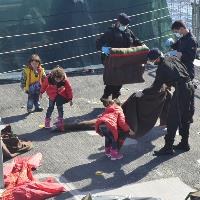(BRUSSELS) – With a growing number of children in migration arriving in the EU over the past two years, many without their families, the EU has set out actions to reinforce the protection of migrant children at all stages of the process.
While EU and Member States’ legislation provide a solid framework for protection, a recent surge in arrivals has put national systems under pressure and also exposed gaps and shortcomings.
The EU executive says trained personnel need to be available to assist children during their status determination and children should be provided with sustainable long-term perspectives through better access to education and health care.
The Commission says it will continue to support Member States’ efforts through training, guidance, operational support and funding.
“It is our moral duty as well as our legal responsibility,” said the EC’s First Vice-President Frans Timmermans. “Children should be our top priority as they are the most vulnerable, especially when they have nobody to guide them. That is why today we are setting out a number of concrete actions to better protect, support and take care of the best interests of all children who are arriving in the European Union.”
Migration Commissioner Dimitris Avramopoulos said: “Today we propose concrete actions to support our Member States in addressing the needs of all children at all stages of migration: to improve the identification of children, to train involved personnel, to step up relocation, but also to ensure swift family tracing in countries of origin and measures to enhance early integration.”
Drawing on expertise from all relevant policy areas, the Commission is proposing a number of priority areas for Member States to focus on, supported by the Commission and EU Agencies, to improve the protection of children in migration and ensure a closer link between the asylum and child protection services:
- Swift identification and protection upon arrival: A person responsible for child protection should be present at an early stage of the registration phase and in all reception facilities hosting children and child protection officers should be appointed in each hotspot. Member States should put in place the necessary procedures to systematically report and exchange information on all missing children.
- Adequate reception conditions for children: The needs of each child must be assessed as early as possible upon arrival and all children need to have access to legal assistance, healthcare, psychosocial support and education without delay and regardless of their status. For unaccompanied minors, the possibility of foster or family-based care should be provided. Everything must be done to provide alternatives to administrative detention for children.
- Swift status determination and effective guardianship: The role of guardians for unaccompanied minors should be strengthened. To this end, the Commission will establish a European guardianship network to exchange good practices. To support the implementation of reliable age-assessment procedures by all Member States, EASO will update its guidance shortly. Concerted efforts should also be made to speed up family tracing and family reunification procedures, within or outside the EU. In all procedures related to the migration process, cases with children should always be given priority. This goes for relocation of unaccompanied migrants from Greece or Italy as well.
- Durable solutions and early integration measures: The Commission will further promote the integration of children through funding and the exchange of good practices.Member States are called upon to step up resettlement of children in need of protection and to ensure that family tracing and reintegration measures are put in place for those children who are to be returned.
- Addressing root causes and protecting children along migrant routes outside the EU: The EU has stepped up its work with partner countries on mainstreaming child protection in migration under the Migration Partnership Framework. Further efforts are needed to support partner countries in strengthening national child protection systems and in preventing child trafficking. A timely follow-up to the recently-renewed EU Guidelines on the promotion and protection of the rights of the child, including in countries of origin and transit, should be ensured.
The number of child migrants arriving in Europe has increased significantly. In 2015 and 2016, 30 per cent of asylum applicants in the EU were children.
As children in migration are exposed to high risks of violence, trafficking or exploitation along migration routes or may go missing, or become separated from their families, they require a specific protection. Children have the right to be protected, in line with relevant provisions of EU law, including the EU Charter of Fundamental Rights, and with international law on the rights of the child. The child’s best interests must be the primary consideration in all actions or decisions concerning children.
Communication: The protection of children in migration
Commission Staff Working Document: Implementing the Action Plan on Unaccompanied Minors (2010-2014)
Questions & Answers: Protecting Children in Migration


